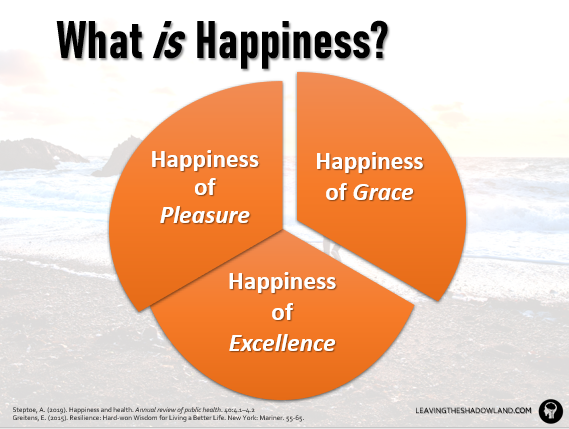
Some folks got a light around them that shine for other peoples. I think that maybe some of them was in tunnels, and in that tunnel, maybe the only light they had was inside of them. And then, even long after they escaped that tunnel… They still be shining for everybody else.”
Sapphire
Dr. Harold Greenwald had been a practicing therapist for 30 years when a client came to him with a unique request.
“So what brings you here today?” he asked her.
She smiled warmly. “Well, I don’t really have any big problem I need to talk about.”
I imagine that when therapists hear this, they don’t always quite believe it. After all, clients don’t usually seek counseling unless something is wrong. So Dr. Greenwald waited for her to describe what was ailing her.
Instead she said, “I’m actually a pretty happy person.”
What kind of ailment is that? he thought. What does she need me for? She soon solved the mystery.
“I came to see you, Doctor, to see if you have any professional advice on how to get happier.”
How many times do you think Dr. Greenwald had heard that before?
Zero. Nada. Not one of his previous clients had ever asked him how to get happier.
He realized at that moment that he had become an expert on misery. He knew how to help people through the shadowlands of life – grief, sadness, anger, worry, and depression – but he didn’t have a clue how to help this client who was already happy and just wanted to increase her happiness.
What makes people happy? He didn’t know.
So he began to interview happy people to discover what made them happy. He became a happiness researcher. And when he finished, he wrote a delightful little book called The Happy Person.1
Scores of books have been written in the same vein since The Happy Person was first published, way back in 1985. But I reference it here because Dr. Greenwald’s conclusions have stood the test of time. What he said then is just as true today.
I’ll tell you his conclusions in a minute, but first let’s talk about a psychological concept called locus of control.
There are basically two types of control we can believe are at work in life: external or internal.
So when clients present their problems, one of the things the therapist explores is who or what the clients believe is responsible for them—either factors that are external to the clients and over which they feel they have no control (such as other people, fate, luck, or chance), or factors that are internal and over which the clients feel they do have some control (such as their own thinking and attitudes and an acceptance of personal responsibility).
Generally speaking, clients who believe that they exercise some control over the problems they face and solutions they seek are the ones that therapists are most successful in helping.
Last year in my blog, I wrote a long series on cognitive behavioral therapy, including the distorted beliefs we sometimes use. What would happen if, instead of using distorted beliefs, we filtered everything that happens to us through stress-reducing beliefs?
How would you and I view life differently if we always thought: I control my own beliefs, opinions, desires, and happiness?
Every stressful situation should be filtered through this belief. In fact, living by this belief regularly, will save us from a lot of stress ever developing. This belief says that in every situation you have some measure of control; if not always over the situation itself, then at least over your response to it.
THE HAPPY PERSON
Dr. Greenwald’s research led him to a surprising discovery, described at the beginning of his book.
My most surprising discovery was how many of the joyous, satisfied people I interviewed for this book had undergone traumas, frustrations, and defeats remarkably similar to my misery-laden patients.” 1
We often think that problems and happiness are inversely related: as the first goes up, the second is sure to go down. Dr. Greenwald’s research, conducted several decades ago now, has disabused that notion.
The happy people he interviewed experienced the same kinds of problems as did the unhappy people who came to him for therapy. Happiness did not result from a miraculous lack of problems that other people have had to encounter.
So something else accounted for their happiness. What was it?
Dr. Greenwald continued his analysis:
The happy people I interviewed in preparing this book had all chosen not to be victims. . . . They had chosen to be happy. . . . Most often the decision was made on the heels of a severe emotional or physical crisis in their lives–a near-fatal accident, or a disastrous divorce, etc.” 1
So if you’re in the midst of a personal crisis of some kind right now, this could be a turning point time in your life. Some good things could happen.
Now these are clearly the circumstances many sad people use to explain their unhappiness. So why weren’t these people sad?
Again and again I found that they made use of such circumstances to reexamine their way of looking at the world. . . . They then decided, consciously or unconsciously, they were responsible for their own happiness.”1
Happy people are happy because they choose to be happy.
None of us are spared from the trials of life. But some look at their trials differently, have different attitudes toward their trials, and work with a set of beliefs that allow them to rise above their trials and still maintain their happiness.
Abraham Lincoln was no stranger to problems and depression. Yet he said, “People are as happy as they make up their minds to be.”
There’s plenty of clinical evidence today that proves him right.
WHAT IS HAPPINESS?
What exactly is happiness? Different people will give you different answers to that question. In the psychological definition, happiness is thought to have three components.2 Here I will use the less clinical terms that Eric Greitens uses in his book on resilience:3

The “Happiness of Pleasure”3
What parts of life bring you pleasure?
When I ask my clients this question, they say things like, “my husband/wife,” “taking a walk in nature,” “gardening,” and “eating a good meal.” And I agree with all of these.
All of these and more can cause dopamine surges in the brain, flowing and crashing in waves of pure, hedonic joy.
Pleasure is often the first feeling that comes to mind when we think of happiness: “Am I happy? Gee, I don’t know. Do I feel happy?”
But pleasure has its limits. In nerdy scientific terms, we would say that it is usually necessary, but never sufficient, for true happiness. We need the other two components as well:
The “Happiness of Grace”
I am not using “grace” here in its spiritual meaning, receiving forgiveness or favor from God that we do not deserve. But we do often feel this happiness in the acts of prayer or reflection on our gifts.
We feel the happiness of grace whenever we say “Thank you” for something.
Greitens writes,
Think of the sense of joy and peace that comes over us when we pause, even for a moment, and genuinely say “thank you”….in every civilization we find evidence that human beings have long sought and long enjoyed the happiness of grace: the sense that there is an order to the cosmos, and awareness of the gift of life, and an appreciation for our own place in it.”4
The “Happiness of Excellence”
This involves the pursuit of worthy goals and achieving those goals. In Greek moral philosophy, eudaimonia is used to refer to the right actions as those that result in the well-being of an individual. Greitens wrote:
We can all think of people…who made great sacrifices in their search for a purpose, because they knew that their lives wouldn’t be complete without one.
One of those people was Hannah Senesh. When she left her native Hungary to emigrate to Palestine, she wrote in her diary, ‘I’ve become a different person, and it’s a very good feeling. One needs something to believe in, something for which one can have whole-hearted enthusiasm. One needs to feel that one’s life has meaning, that one is needed in this world.’
She lived by those words. A few years later, at the age of 23, she volunteered to parachute into a war zone, sneak behind Nazi lines, and rescue Hungarian Jews on the verge of being sent to Auschwitz. She become a symbol of heroism and purpose to those who came after her and learned her story….
The lesson I take from her is that the pull of purpose, the desire to feel ‘needed in the world’…is a very powerful force in human life…The desire to live well and purposefully isn’t some grim, ugly, teeth-gritting duty. On the contrary…it really is happiness.”5
There are two points I want to make here.
First, true happiness, a true sense of well-being, will be incomplete unless it has all three components.
Second, a lot of one of these components will not make up for a lack in the others.
A lot of people equate happiness with pleasure, while others insist that pleasure is bad. They’re both wrong.
Pleasure, in and of itself, does not – indeed cannot – take the place of gratitude, purpose and meaning. Pleasure is only part of the whole.
This is why we don’t have to feel happy in order to be happy. Gratitude, purpose, and meaning do not necessarily start out as feelings, although sometimes feelings of happiness come later. Rather, all are intentional choices we make every day of our lives.
HAPPINESS IS LINKED TO:
Research studies have linked all three components to:
- Greater stability
- Family satisfaction
- Relationship satisfaction
- Better job performance
- Disease resistance
- Better physical & emotional health
HAPPINESS AND LONGEVITY
Does whether or not we make a choice to be happy make an overall difference to our health and longevity? You bet.
A group of researchers recently combined the results of 62 separate studies that had been done in the general population on the effects of happiness on longevity.6 The number of research participants in this “meta-analysis” were over 1.25 million.
The participants were asked to report how high they felt they were in the three dimensions of happiness. “Happy” people were those who scored high in all three dimensions; “unhappy” people scored low in the same dimensions. Both groups were then followed over time to see if the mortality rate differed between “happy” and “unhappy” people.
All three dimensions of happiness decreased the mortality risk in this study after adjusting for all lifestyle factors by about 8%.
Part of this may be because happy people take care of themselves better. And it’s true that happy people:
- Exercise more
- Eat more fruit & veggies
- Smoke & drink less
- Use more sunscreen
- Get more physical exams
But there are physiological differences as well. Happy people have:
- Less cortisol
- Less inflammation
- Better heart health
- Better cholesterol profile
- Less wear & tear due to stress (technically called “allostatic load”)
THE GOOD WEATHER FACTOR
Steven Covey says there are people who allow the weather to control their feelings—if it’s a sunny day, they feel good, but if it’s a cloudy day, they feel down in the dumps.
He says proactive people create their own internal good weather and carry it with them. We could call this The Good Weather Factor: taking responsibility for your life–your emotions and behavior—for your own happiness and success.
This is a powerful belief. Committing ourselves to it means that you and I can actually create our own internal good weather that can transform the stormiest period of life into a time of sunshine and growth.
This does not mean that difficult things won’t happen to you; there will be many stressors in life.
But it’s a matter of choosing to create good weather out of the stormiest day, like Dr. Greenwald’s happy patients did.
1 Greenwald, H., Rich, E. (1985). The Happy Person. Avon Books.
2 Steptoe, A. (2019). Happiness and health. Annual review of public health. 40:4.1–4.2
3 Greitens, E. (2015). Resilience: Hard-won Wisdom for Living a Better Life. New York: Mariner. 55-65.
4 Greitens, E. (2015). Resilience: Hard-won Wisdom for Living a Better Life. New York: Mariner. 57.
5 Greitens, E. (2015). Resilience: Hard-won Wisdom for Living a Better Life. New York: Mariner. 60.
6 Martín-María, N., Miret, M., Caballero, F. F., Rico-Uribe, L. A., Steptoe, A., Chatterji, S., & Ayuso-Mateos, J. L. (2017). The impact of subjective well-being on mortality: a meta-analysis of longitudinal studies in the general population. Psychosomatic medicine, 79(5), 565-575.
Dr. Pamela Coburn-Litvak has published research articles on exercise and stress in Neuroscience and Neurobiology of Learning and Behavior. Her latest book, Leaving the Shadowland of Stress, Anxiety, and Depression, was published in 2020.
After receiving a Ph.D. in Neurobiology and Behavior from the State University of New York at Stony Brook, she served as both Assistant Professor of Physiology & Pharmacology and Special Assistant to the Vice President for Research Affairs at Loma Linda University in Loma Linda, California. She then joined the Biology department at Andrews University and developed courses in human physiology as well as the neurobiology of mental illness. She also founded Rock @ Science LLC, a company that specializes in health and science education and web development. She co-developed the brain and body physiology segment of the Stress: Beyond Coping seminar with its creator, Dr. William “Skip” MacCarty, DMin.
Dr. Coburn-Litvak currently lives in California with her husband. Their two daughters are mostly grown and attending school elsewhere.
When she’s not studying or teaching about stress, she enjoys stress-relieving activities like puttering around the garden, taking nature walks with her family, knitting, cooking, and reading.


